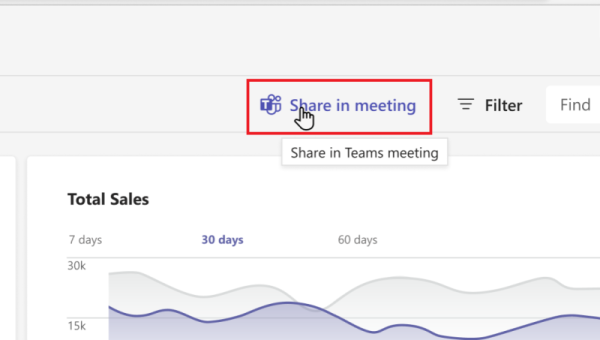Share in meeting
Share in meeting allows users to share documents or third-party web apps to the meeting stage. The meeting participants can collaborate and interact with the third-party web apps or edit the documents together.
The following image shows the Share in meeting button on the web app:

During the meeting, when a user selects the Share in meeting button from the third-party web app or document, it launches a deep link to the meeting stage and opens the app as a web view in the meeting stage. For the meeting participants to interact with third-party web app or document, they must have meeting extension of the app or document installed in their Teams client. If they don't have meeting extension, Teams prompts participants to install the meeting extension.
When you select the Share in meeting button, it launches a deep link to the meeting stage. The following is the deep link format:
msteams:/l/meeting-share?deeplinkId={GUID}&fqdn={string}&lm=deeplink&appContext={json encoded app context}
For more information, see generate a deep link to share content to stage in meetings.
Enable share in meeting
The following are three different methods to enable share in meeting. You can use one of the methods depending on how much control you want on the Share in meeting buttons displayed on your web page:
This method is the simplest way to display the share in meeting buttons with minimal customizations. You can customize the button styles, size, and languages.
You can scan your web page to locate any HTML elements with the class name of type teams-share-in-meeting-button and dynamically generate Share in meeting buttons in your page.
Add the
launcher.jsscript on your webpage.<script async defer src="https://teams.microsoft.com/share/launcher.js"></script>Add an HTML element on your webpage with the
teams-share-in-meeting-buttonin theclassattribute, the app ID (from manifest) in thedata-app-idattribute, and the link to share in thedata-hrefattribute. You can also include thedata-entity-nameanddata-entity-descriptionattributes.<div class="teams-share-in-meeting-button" data-href="https://<link-to-be-shared>" data-app-id="<app-id>" data-entity-name="<app-name>" data-entity-description="<app-content-description>" > </div>Following are the additional attributes to customize Share in meeting button:
data-button-type: Specifies the background color of the button (primaryShareInMeetingorsecondaryShareInMeeting).data-button-size: Specifies the size of the button in pixel.data-target: Specifies whether the link opens in the same window, new tab, or a new window.data-locale: Specifies the desired user language.
The following are the launcher.js definitions:
| Property | HTML attribute | Type | Required | Default | Description |
|---|---|---|---|---|---|
| url | data-href |
String | Yes | NA | URL of the app content to share. |
| appId | data-app-id |
String | Yes | NA | ID of the app to share. |
| entityName | data-entity-name |
String | No | NA | App entity name. |
| entityDescription | data-entity-description |
String | No | NA | Description of app content to share. |
| locale | data-locale |
String | No | en-US | User preferred language. |
| target | data-target |
String | No | self | Specifies whether the link opens in the same window, new tab, or new window. |
| buttonType | data-button-type |
String | No | primaryShareInMeeting | Specifies the button background color: primaryShareInMeeting or secondaryShareInMeeting. |
| buttonSize | data-button-size |
String | No | NA | Button size in pixels. |
End user experience on third-party apps
After you enable Share in meeting on third-party apps, you can share the apps to the meeting stage. To access, follow the steps:
If meeting extension is installed:
Open the web app in the browser and select Share in meeting.
Select Start sharing.

The web app is shared to meeting stage and all the participants can interact and edit together.

If meeting extension isn't installed:
Open the web app in the browser and select Share in meeting.
To install the meeting extension app, select Add.
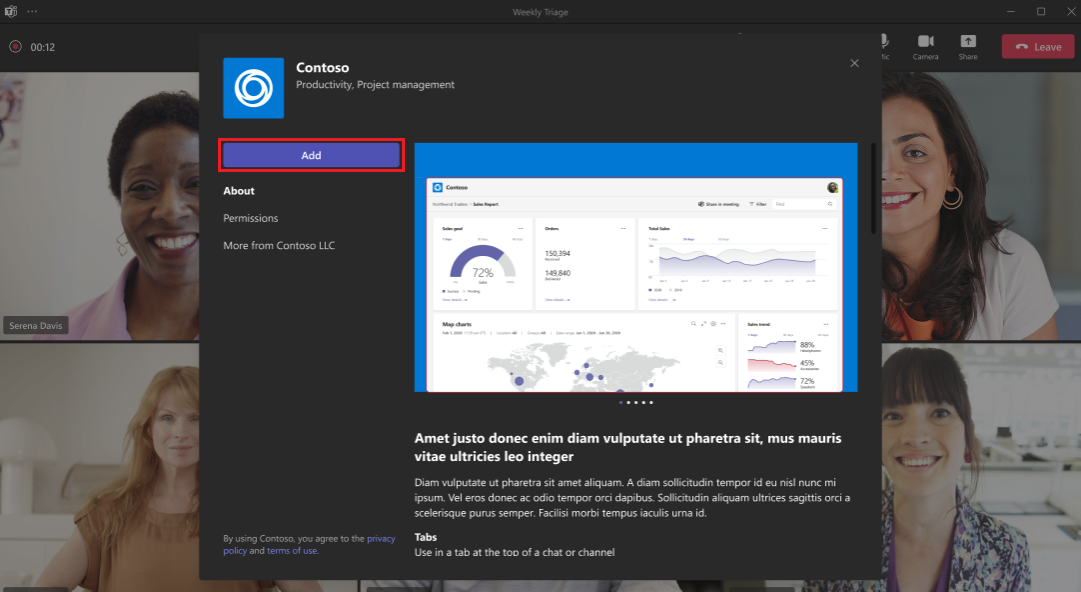
Select Start sharing.

The web app is shared to meeting stage and all the participants can interact and edit together.

Generate a deep link to share content to stage in meetings
You can also generate a deep link to share the app to stage and start or join a meeting. When a deep link is selected in an app by a user who is part of an ongoing meeting, then the app is shared to the stage and a permission pop-up window appears. Users can grant access to the participants to collaborate with an app.
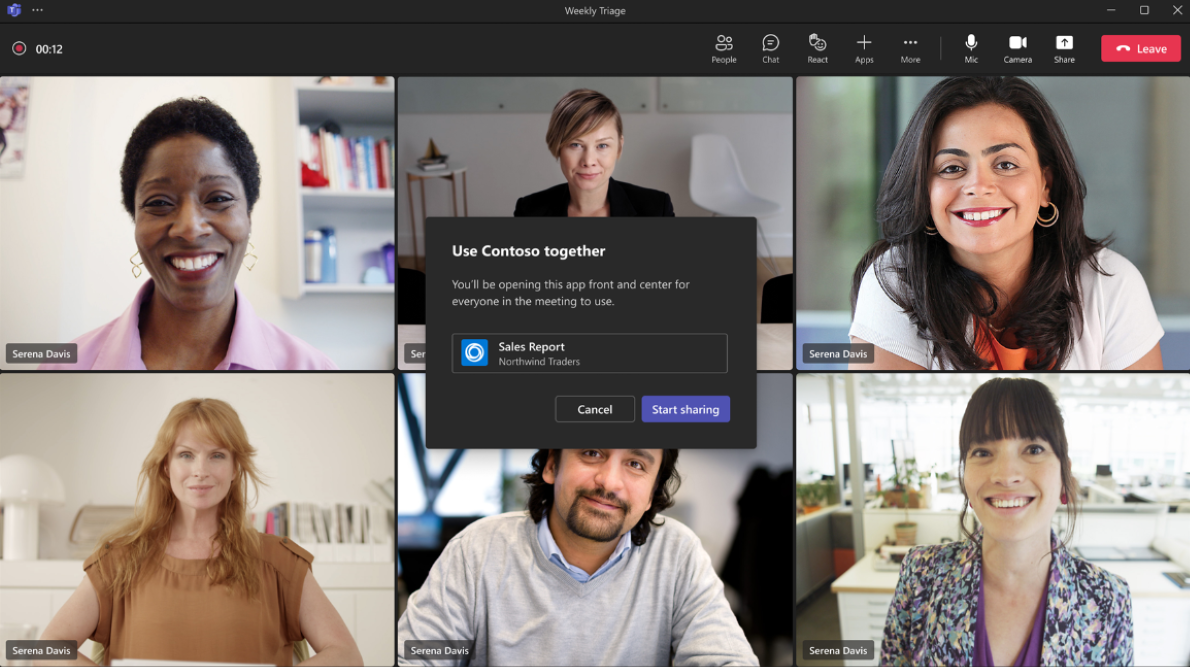
When a user isn't in a meeting then the user is redirected to the Teams calendar where they can join a meeting or initiate instant meeting (Meet now).
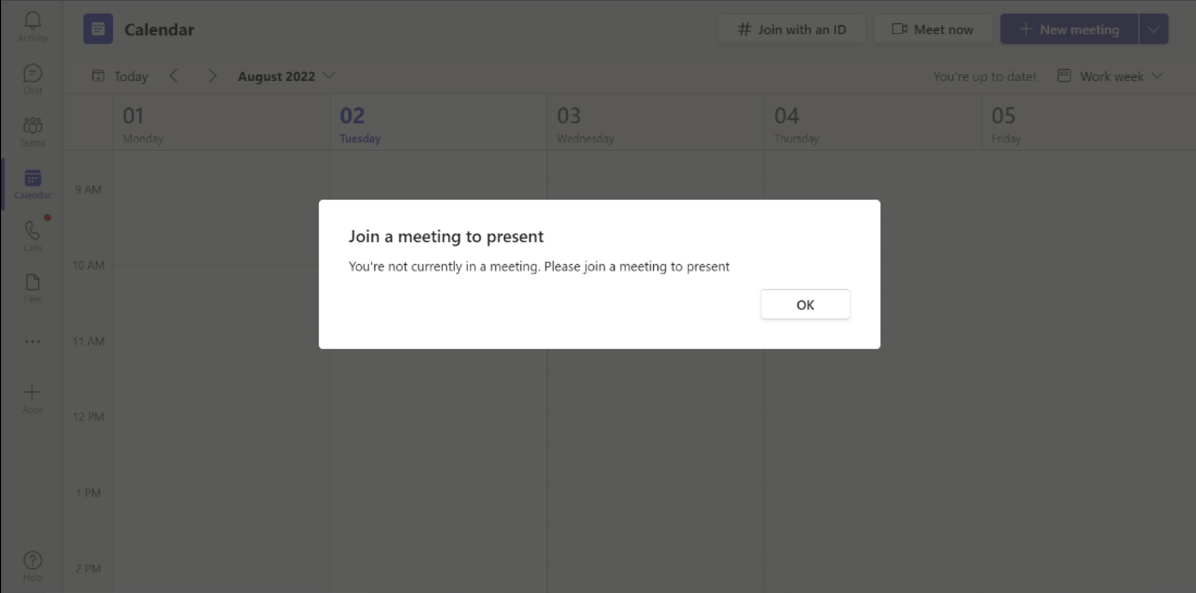
Once the user initiates an instant meeting (Meet now), they can add participants and interact with the app.
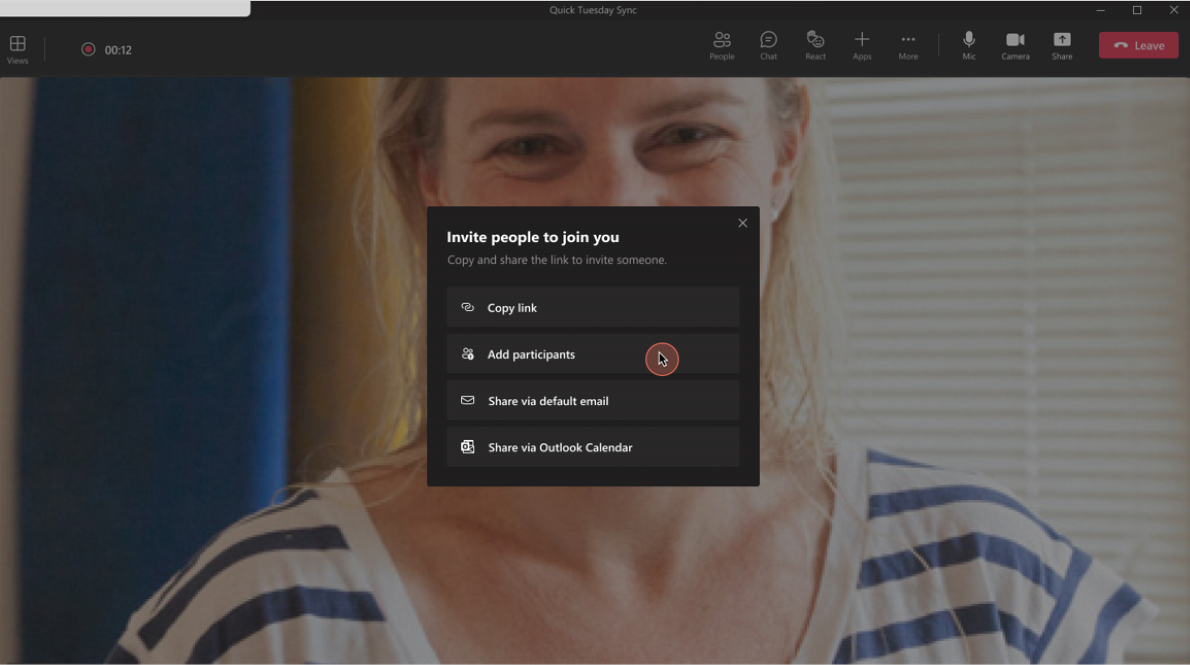
To add a deep link to share content on stage, you need to have an app context. The app context allows the Teams client to fetch the app manifest and check if the sharing on stage is possible. The following is an example of an app context:
{ "appSharingUrl" : "https://teams.microsoft.com/extensibility-apps/meetingapis/view", "appId": "9ec80a73-1d41-4bcb-8190-4b9eA9e29fbb" , "useMeetNow": false }
The query parameters for the app context are:
appID: This is the ID that can be obtained from the app manifest.appSharingUrl: The URL, which needs to be shared on stage should be a valid domain defined in the app manifest. If the URL isn't a valid domain, an error dialog appears to provide the user with a description of the error.useMeetNow: This includes a Boolean parameter that can be either true or false.True: When the
useMeetNowvalue is true and if there's no ongoing meeting, a new Meet now meeting will be initiated. When there's an ongoing meeting, this value will be ignored.False: The default value of
useMeetNowis false, which means that when a deep link is shared to stage and there's no ongoing meeting, a calendar pop-up will appear. However, you can share directly during a meeting.
Ensure that all the query parameters are properly URI encoded and the app context has to be encoded twice in the final URL. Following is an example:
const appContext= JSON.stringify({
"appSharingUrl" : "https://teams.microsoft.com/extensibility-apps/meetingapis/view",
"appId": "9cc80a93-1d41-4bcb-8170-4b9ec9e29fbb",
"useMeetNow": false
});
const encodedContext = encodeURIComponent(appContext).replace(/'/g,"%27").replace(/"/g,"%22");
const encodedAppContext = encodeURIComponent(encodedContext).replace(/'/g,"%27").replace(/"/g,"%22");
A deep link can be launched either from the Teams web or from the Teams desktop or mobile client.
Teams web: Use the following format to launch a deep link from the Teams web to share content on stage:
msteams:/l/meeting-share?deeplinkId={GUID}&fqdn={string}&lm=deeplink&appContext={json encoded app context}Example:
https://teams.microsoft.com/l/meeting-share?deeplinkId={sampleid}&fqdn=teams.microsoft.com&lm=deeplink%22&appContext=%257B%2522appSharingUrl%2522%253A%2522https%253A%252F%252Fteams.microsoft.com%252Fextensibility-apps%252Fmeetingapis%252Fview%2522%252C%2522appId%2522%253A%25229cc80a93-1d41-4bcb-8170-4b9ec9e29fbb%2522%252C%2522useMeetNow%2522%253Atrue%257DDeep link Format Example To share the app and open Teams calendar, when useMeeetNowis false, default.https://teams.microsoft.com/l/meeting-share?deeplinkId={deeplinkid}&fqdn={fqdn}}&lm=deeplink%22&appContext={encoded app context}https://teams.microsoft.com/l/meeting-share?deeplinkId={sampleid}&fqdn=teams.microsoft.com&lm=deeplink%22&appContext=%257B%2522appSharingUrl%2522%253A%2522https%253A%252F%252Fteams.microsoft.com%252Fextensibility-apps%252Fmeetingapis%252Fview%2522%252C%2522appId%2522%253A%25229cc80a93-1d41-4bcb-8170-4b9ec9e29fbb%2522%252C%2522useMeetNow%2522%253Afalse%257DTo share the app and initiate instant meeting, when useMeeetNowis true.https://teams.microsoft.com/l/meeting-share?deeplinkId={deeplinkid}&fqdn={fqdn}}&lm=deeplink%22&appContext={encoded app context}https://teams.microsoft.com/l/meeting-share?deeplinkId={sampleid}&fqdn=teams.microsoft.com&lm=deeplink%22&appContext=%257B%2522appSharingUrl%2522%253A%2522https%253A%252F%252Fteams.microsoft.com%252Fextensibility-apps%252Fmeetingapis%252Fview%2522%252C%2522appId%2522%253A%25229cc80a93-1d41-4bcb-8170-4b9ec9e29fbb%2522%252C%2522useMeetNow%2522%253Atrue%257DTeams desktop or mobile client: Use the following format to launch a deep link from the Teams desktop or mobile client to share content on stage:
msteams:/l/meeting-share?deeplinkId={deeplinkid}&fqdn={fqdn}&lm=deeplink&appContext={encoded app context}Example:
msteams:/l/meeting-share?deeplinkId={sampleid}&fqdn=teams.microsoft.com&lm=deeplink%22&appContext=%257B%2522appSharingUrl%2522%253A%2522https%253A%252F%252Fteams.microsoft.com%252Fextensibility-apps%252Fmeetingapis%252Fview%2522%252C%2522appId%2522%253A%25229cc80a93-1d41-4bcb-8170-4b9ec9e29fbb%2522%252C%2522useMeetNow%2522%253Atrue%257DDeep link Format Example To share the app and open Teams calendar, when useMeeetNowis false, default.msteams:/l/meeting-share? deeplinkId={deeplinkid}&fqdn={fqdn}&lm=deeplink%22&appContext={encoded app context}msteams:/l/meeting-share?deeplinkId={sampleid}&fqdn=teams.microsoft.com&lm=deeplink%22&appContext=%257B%2522appSharingUrl%2522%253A%2522https%253A%252F%252Fteams.microsoft.com%252Fextensibility-apps%252Fmeetingapis%252Fview%2522%252C%2522appId%2522%253A%25229cc80a93-1d41-4bcb-8170-4b9ec9e29fbb%2522%252C%2522useMeetNow%2522%253Afalse%257DTo share the app and initiate instant meeting, when useMeeetNowis true.msteams:/l/meeting-share? deeplinkId={deeplinkid}&fqdn={fqdn}&lm=deeplink%22&appContext={encoded app context}msteams:/l/meeting-share?deeplinkId={sampleid}&fqdn=teams.microsoft.com&lm=deeplink%22&appContext=%257B%2522appSharingUrl%2522%253A%2522https%253A%252F%252Fteams.microsoft.com%252Fextensibility-apps%252Fmeetingapis%252Fview%2522%252C%2522appId%2522%253A%25229cc80a93-1d41-4bcb-8170-4b9ec9e29fbb%2522%252C%2522useMeetNow%2522%253Atrue%257D
The query parameters are:
deepLinkId: Any identifier used for telemetry correlation.fqdn:fqdnis an optional parameter, which can be used to switch to an appropriate environment of a meeting to share an app on stage. It supports scenarios where a specific app share happens in a particular environment. The default value offqdnis enterprise URL and possible values areTeams.live.comfor Teams for Life,teams.microsoft.com, orteams.microsoft.us.
To share the entire app to stage, in the app manifest, you must configure meetingStage and meetingSidePanel as frame contexts, see app manifest. Otherwise, meeting attendees may not be able to see the content on stage.
Note
For your app to pass validation, when you create a deep link from your website, web app, or Adaptive Card, use Share in meeting as the string or copy.
Code sample
| Sample name | Description | .NET | Node.js | Manifest |
|---|---|---|---|---|
| Meeting Stageview | This app helps to enable and configure your apps for Teams meetings. It also demonstrates use of share in meeting feature. | View | View | View |
See also
Platform Docs
Feedback
Coming soon: Throughout 2024 we will be phasing out GitHub Issues as the feedback mechanism for content and replacing it with a new feedback system. For more information see: https://aka.ms/ContentUserFeedback.
Submit and view feedback for
